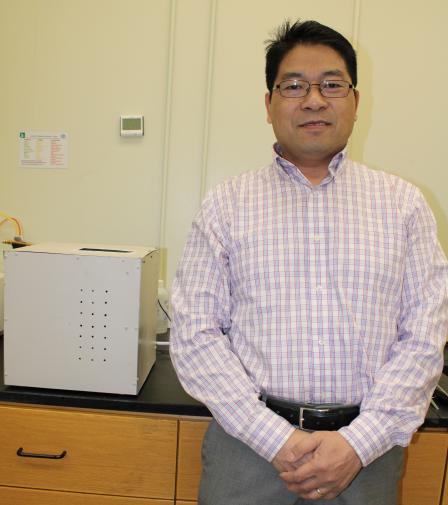News Releases from Region 02
Long Island Scientist Wins EPA Advanced Septic System Nitrogen Sensor Challenge
NEW YORK (May 5, 2020) Today, the U.S. Environmental Protection Agency (EPA) announced that a scientist from Stony Brook University in Stony Brook, NY, has won the Advanced Septic System Nitrogen Sensor Challenge, an international competition to advance the development of low-cost sensors to measure nitrogen levels discharged from advanced home septic systems. Dr. Qingzhi Zhu, with Stony Brook University and the New York State Center for Clean Water Technology earned the Challenge’s prize of $50,000, the opportunity for commercialization support, eligibility for further testing and verification of the sensor technology’s performance by the globally-recognized International Organization for Standardization (ISO) Environmental Technology Verification (ETV) 14034 standard.
“This competition shows that great innovations start small and can have potentially huge benefits,” said EPA Regional Administrator Pete Lopez. “EPA encourages the development of innovative water sensor technologies to help reduce nitrogen load and protect human health.”

Dr. Zhu’s sensor package (pictured above) met rigorous testing goals at the Massachusetts Alternative Septic System Test Center (MASSTC) and shows great promise to help address the significant ecological and water quality issues caused by excess nitrogen. The ability to measure nitrogen concentration exiting advanced septic systems will provide real-time data on the performance of these systems and help safeguard water quality in coastal communities.
“Researchers at Stony Brook University have long been at the forefront of cutting-edge research that directly impacts their fellow Long Islanders,” said Congressman Lee Zeldin (NY-01). “In Suffolk County, our environment is an integral part of our way of life, and Dr. Zhu’s groundbreaking work will go a long way in reliably safeguarding our communities' water quality.”
“As our historic efforts to reverse nitrogen impacts to water quality continue, Suffolk County is proud of its strong working relationship with the Center for Clean Water Technology, and greatly appreciative of the support we continue to receive from EPA,” said Suffolk County Executive Steve Bellone. “This well-deserved recognition is clear indication of the importance of the investment that Governor Cuomo has made in establishing the Center. Congratulations to Dr. Gobler and the staff at CCWT for this outstanding achievement.”
“The Nature Conservancy congratulates Dr. Zhu and the New York State Center for Clean Water Technology on this groundbreaking achievement and well-deserved award,” said Long Island Chapter Director of The Nature Conservancy Nancy Kelley. “On Long Island, nitrogen pollution from sewage threatens our health, economy, and way of life. This new technology is an exciting leap forward that will allow inexpensive, real-time monitoring to accelerate our progress on restoring and protecting our drinking water and surface water from the destructive effects of nitrogen pollution.”
“The New York State Center for Clean Water Technology was founded to develop water quality protection technologies and since our founding we have developed a series of innovative and alternative (I/A) septic systems that remove 80-90% of nitrogen and organic pollutants from wastewater,” said New York State Center for Clean Water Technology Director Dr. Chris Gobler. “With this sensor, the Center moves in a new important direction, providing the technology necessary for monitoring the performance of I/A systems and potentially nitrogen levels in surface waters across the globe. The Center is extremely grateful for the support from EPA, TNC, NYS Department of Environmental Conservation, and Suffolk County in advancing this sensor.”
“Our low-cost nitrogen sensor package is reliable and rugged and it has great potential to be commercialized and applied in advanced septic systems for long-term deployment,” said Stony Brook University Associate Professor Dr. Qingzhi Zhu. “I am very excited that our nitrogen sensor package met the Challenge criteria and won the award for the Phase II, 7-day field performance test at MASSTC. I feel extremely privileged to have taken part in this wonderful Challenge, which was sponsored by the U.S. EPA.”
Because conventional septic systems are not always designed to remove nitrogen to levels protective of local water quality, they can contribute to excess nitrogen in groundwater that often serves as drinking water and eventually find its way to nearby waterways. In waterways, this excess nitrogen can cause eutrophication (murky water due to an increase in organic matter and plant biomass), hypoxia (low levels of oxygen in the water making it hard for fish to breathe), harmful algal blooms and fish kills, which can have potentially serious economic impacts on communities. There are millions of existing septic systems nationwide that could be good candidates to be replaced with advanced septic systems, which are designed to reduce nitrogen by at least half. Adding nitrogen sensors to advanced septic systems will help manufacturers, homeowners, local and state governments know that these systems are performing as intended in order to protect our valuable ground and surface water resources.
EPA, in partnership with The Nature Conservancy in New York and the US Geological Survey, launched the Advanced Septic System Nitrogen Sensor Challenge in 2017 to address the need for a low-cost nitrogen sensor that could be deployed with advanced onsite wastewater treatment or septic systems. The Challenge, comprised of a sensor design phase and multiple rounds of sensor prototype testing in real septic tank effluent, concluded in August 2019 with a one-week test of three sensors at MASSTC in Barnstable, MA. Dr. Zhu’s winning sensor maintained outstanding accuracy for nitrogen and ammonium that met or surpassed testing goals.
EPA is offering a free webinar on May 27, 2020 from 2:00 PM to 3:30 PM EDT, featuring Dr. Zhu, EPA, and the Director of MASSTC. For more information, please visit: https://register.gotowebinar.com/register/7157478055790840075
For more information about the Challenge, please visit: https://19january2021snapshot.epa.gov/innovation/advanced-septic-system-nitrogen-sensor-challenge-phase-ii-prototype-testing
Follow EPA Region 2 on Twitter at http://twitter.com/eparegion2 and visit our Facebook page, http://facebook.com/eparegion2
20-033
# # #
